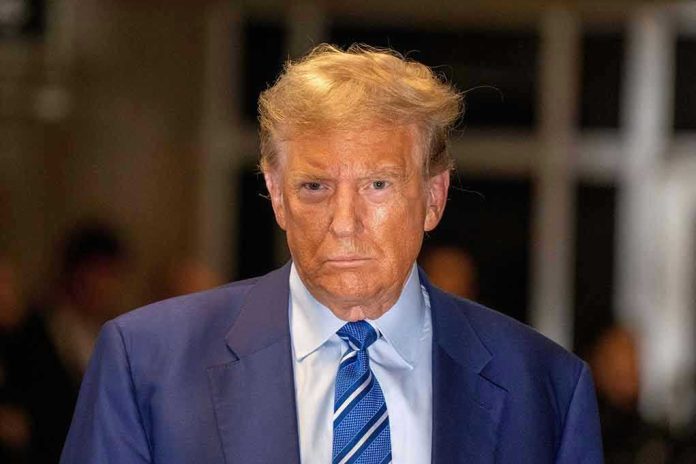
President Trump’s direct approach with Ukrainian President Volodymyr Zelensky has sparked heated debate as reports emerge of a tense White House confrontation where the President delivered blunt warnings about the consequences of refusing to negotiate with Russia.
Story Snapshot
- President Trump held intense closed-door meeting with Zelensky on October 17, 2025, pressing for negotiated settlement with Russia
- Meeting followed Trump-Putin phone call where Russian leader warned of severe consequences if Ukraine refuses negotiations
- Exchange reportedly escalated as Trump warned Zelensky that Putin could “destroy” Ukraine militarily
- Meeting highlights Trump administration’s push to end costly foreign entanglement and bring warring parties to negotiating table
Trump Pushes for Negotiated Settlement
President Trump met with Ukrainian President Volodymyr Zelensky at the White House on October 17, 2025, in what sources describe as an extraordinarily frank exchange about Ukraine’s strategic position. Trump pressed Zelensky to seriously consider negotiating with Russia to end the conflict that has drained American resources and stretched Western unity. The meeting came one day after Trump spoke with Russian President Vladimir Putin, during which Putin outlined severe consequences if Ukraine continued refusing diplomatic solutions. Trump’s approach reflects his campaign promise to end endless foreign wars and prioritize American interests over globalist entanglements that have cost taxpayers billions.
Reality Check on Ukraine’s Military Position
The President reportedly delivered harsh assessments of Ukraine’s military capabilities against Russia’s overwhelming force projection. Trump emphasized that continued conflict without negotiation could result in catastrophic outcomes for Ukraine, warning that Putin possesses the military capacity to devastate Ukrainian positions if diplomacy fails. This realistic appraisal stands in contrast to the previous administration’s approach of endless aid commitments without clear strategic objectives or exit strategies. Many conservatives have questioned why American taxpayers should indefinitely fund a conflict with no apparent resolution while domestic priorities like border security and infrastructure remain underfunded. Trump’s willingness to speak frankly about military realities demonstrates leadership focused on achievable outcomes rather than feel-good rhetoric that prolongs suffering.
Breaking From Failed Establishment Policy
The confrontation reveals Trump’s departure from establishment foreign policy that has characterized Washington’s Ukraine approach since 2022. Previous policies funneled over $100 billion in American resources to Ukraine with minimal accountability or strategic planning for conflict resolution. Trump’s direct engagement with both Putin and Zelensky signals determination to broker practical solutions rather than perpetuate stalemates that enrich defense contractors while draining American coffers. The Russia-Ukraine conflict began in 2014 with Crimea’s annexation and escalated to full-scale invasion in February 2022, creating humanitarian crisis and geopolitical instability. Trump’s approach prioritizes ending bloodshed through negotiation rather than indefinitely prolonging conflict through weapons shipments that risk wider escalation potentially drawing America into direct confrontation with nuclear-armed Russia.
Strategic Implications for American Interests
Trump’s tough-love approach with Zelensky reflects broader recalibration of American foreign policy away from globalist interventionism toward America First principles. The meeting underscores administration priorities: reducing costly foreign entanglements, forcing allies to assume greater responsibility for regional security, and preventing conflicts from escalating into wider wars threatening American servicemembers. Critics who decry Trump’s bluntness ignore that previous diplomatic niceties achieved no breakthrough while casualties mounted and resources depleted. Ukrainian officials reportedly remain committed to resisting Russian territorial demands, but military realities and limited Western appetite for endless conflict may force difficult choices. Trump’s willingness to pressure Zelensky toward negotiation demonstrates commitment to achieving peace rather than managing perpetual crisis that serves establishment interests but harms ordinary Americans and Ukrainians.
The October 17 meeting highlights fundamental tension between idealistic foreign policy rhetoric and pragmatic statecraft. While NATO allies and foreign policy establishment express concern about Trump’s approach, many Americans support ending costly interventions that provide unclear benefits while domestic challenges mount. Trump’s direct communication style with world leaders, though controversial among diplomatic circles, may prove more effective at achieving concrete results than decades of conventional approaches that failed to prevent conflict or secure lasting peace.
Sources:
Protecting The American People Against Invasion – The White House
The Trump Administration’s 2025 Changes to Immigration Law – New York City Bar Association
Immigration policy of the second Trump administration – Wikipedia







